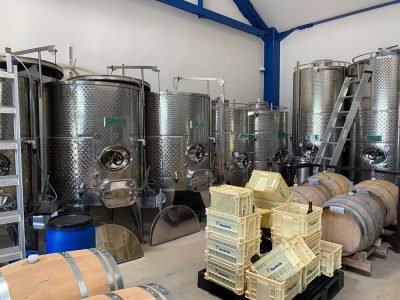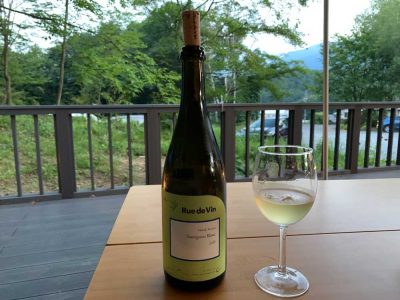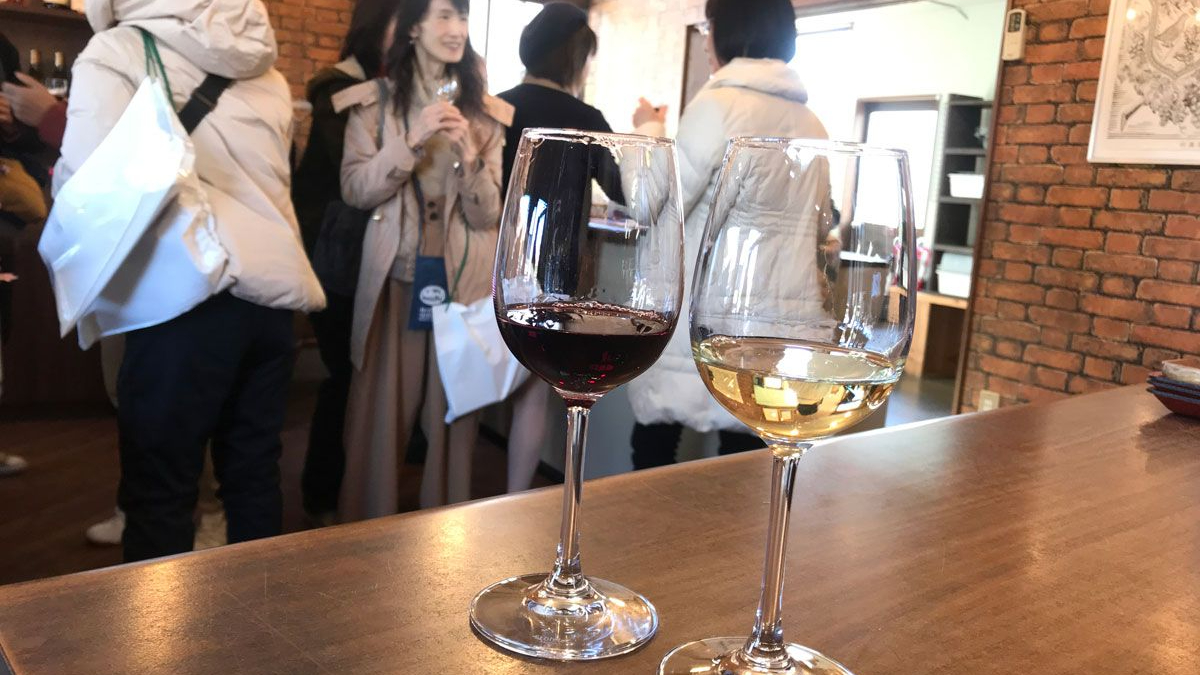There are old-world wines from France and Italy, new-world wines from California, South-Africa, and Chile, and then there is Japanese wine. How did wine end up being made in Japan? Which grape varieties are used? And where are Japan’s wineries?

History of Japanese Wine
In the ancient Nihon-Shoki or Kojiki books written in the 8th century, there are already descriptions of what appear to be grapes. Grape motifs are also found in drawings of the Nara period. We can therefore assume that at that time, the Japanese knew what grapes were. The Koshu grape (甲州) is an indigenous Japanese grape variety native to Europe, which is typically used for Japanese winemaking. It was introduced to Japan in the 8th century, together with the Buddhist teachings.
Until the fourteenth century, the Japanese consumed grapes as a fruit because the Japanese already produced alcohol from rice, sake, and they saw no need to produce another type of alcoholic drink. There are texts from the end of the 16th century that speak of a “European alcohol” that we can assume to be wine. When missionary Francis Xavier arrived in Kagoshima in 1549, he offered wine to the local lords.
Trade with the Portuguese and Dutch favored the reputation of wine. This is how wine gradually gained recognition among the Japanese, but not to the point of producing it on Japanese ground. During the Edo period, grape consumption increased and grape cultivation developed in and around Yamanashi. Commodore Perry arrived in Japan in 1853 and 1854 to ask the Tokugawa Shogunate to open up the country by offering him wine.
The Start of Winemaking in Japan
After the opening of the country in 1868, the Emperor took back the power and decided to modernize the country because Japan was quite behind in industrialization compared to Western countries. The Emperor of Meiji (Mutsuhito), who was a wine lover, encouraged grape cultivation and winemaking as a part of Japan’s industrial development, and together with the government, they decided to import vines from Europe and the United States.
Moreover, at that time the rice harvest was very small, so the government preferred to keep the rice to eat it instead of making sake out of it. The Japanese began winemaking by learning from books and foreign connoisseurs and established their first winery. In 1874, they managed to produce the first Japanese wine from the Koshu grape variety. But as the winemaking technique was not yet developed to the point of producing wine of stable quality, the winery closed after some time.
Adapted To Climate
In 1877, the first private winery in Japan was founded and Tsuchiya Ruken and Takano Masanori were sent to France to learn about winemaking techniques for 2 years. In 1886, this establishment split in two and each continued to study and produce their own wine.
At the same time in Niigata, Kawakami Zenbei learned the grape growing technique from Tsuhiya Ruken who had returned to France. Zenbei then imported many kinds of vines from Europe and the United States and studied the different grape varieties in order to cultivate those that were best adapted to the Japanese climate. Finally, in 1972, he succeeded in developing unique varieties adapted to the climate of Japan including Muscat Bailey A which is still widely used for Japanese winemaking.
Later Developments in Japanese Wine Making
However, the taste of the wine was not adapted to please the palate of the Japanese and didn’t make for a good accompaniment to the Japanese cuisine, but the production of sweet fruit wines continued to develop. During the Second World War, the government encouraged winemaking. The purpose was not to make a drink out of it but for the tartaric acid that is obtained after winemaking. This acid could be used to make submarine detectors and all wineries were placed under state control.
The Olympic Games in Tokyo in 1964 and the Universal Exhibition in Osaka in 1970 gradually changed the Japanese diet to include Western cuisines as well, and wine consumption finally increased. During the economic bubble of 1980, the “Beaujolais Nouveau”, which still causes a sensation every year today, was a huge success. Wine consumption is still gradually increasing, but as far as the spirits market as a whole is concerned, the share of fruit alcohol sales volume is still low at 4.4% (fiscal year 2017).
Climate and Vineyards in Japan

Japan is a long archipelago from north to south and grapes can be cultivated all over the territory: in basins, mountainous regions, hill regions, by the sea, etc. But the climate is generally humid. Except in Hokkaido, there is a rainy season between June and July, a typhoon season between August and September, and at the time of grape harvest, the autumn rainy season.
Native Japanese grapes such as Koshu, Muscat Bailey A, and Delaware are adapted to this very humid climate and are resistant to vine diseases. Many farmers cultivate these varieties but the share of the production volume of these traditional varieties for wine is only 40%. Winegrowers seek to grow European varieties but the humid Japanese climate is not favorable.
Merlot
Merlot is grown in many regions because it is relatively well adapted to the Japanese climate. Koshu fruits are covered with thick skin that protects them from diseases. In addition, the grapes are not densely packed in the bunches and there is a space between them, which allows the wind to pass and protects the grapes from diseases caused by humidity. These characteristics may be what allowed Koshu to survive in the Japanese environment.
In Japan, unlike Europe and the United States (installation of hedges), the installation of shelves for vines is practiced because :
-if we practice the same technique as in Europe or the United States, during the rainy season the soil would become too wet meaning that the leaves near the fruit lack sunlight, and the vines would get sick.
-as water is abundant underground, keeping the vines as shrubs like in Europe would make the stems absorb too much water and cause the fruits to become bland.
Wine-growing Regions in Japan

Wine is produced all over Japan, in Kyoto, Osaka, Hiroshima, and also on the island of Kyushu. But the main wine regions of Japan are Yamanashi, Nagano, and Hokkaido.
Japanese Wine From Yamanashi
There are about 280 wineries in Japan, and 30% of those wineries are concentrated in Yamanashi Prefecture.
Yamanashi Prefecture is the largest wine producer in Japan. The city of Kofu, the capital of Yamanashi Prefecture is located west of Tokyo, about 1h30 by train. It is the closest wine region to the capital. You can make a day trip to a winery from Tokyo to visit the wine cellars.
Yamanashi’s wine center, Kofu is located right next to Mount Fuji. Yamanashi Prefecture is surrounded by mountains: to the south Mount Fuji (3776m), to the west the Japanese Alps (more than 3000m), and to the north the Yatsugatake range (more than 2900m). These mountains protect the region from rain clouds and even during the rainy season and typhoon season, rainfall is low (about 1100mm) and the number of sunshine hours is relatively high. The lower layer of the area’s ground is composed of granite and andesite and its soil is essentially a layer of sandy clay. It is not very well suited for rice cultivation, but it is suitable for fruit trees such as grapes.
As grape cultivation was already very active in Yamanashi (Koshu), the Meiji government built the first winemaking facility in the 1870s. So the history of Japanese wine began in Yamanashi. Yamanashi accounts for 30% (8600 tons) of the total production of grapes for wine. Among these 8600 tons of grapes, Koshu (for white wine) represents 52%, Muscat Bailey A (for red wine) 23.6%, and Delaware 7.8% (for white wine). These figures show that Yamanashi mainly cultivates Japanese grape varieties.
Nagano
There are 2 wine regions in Nagano: Kikyogahara and Chikumagawa Valley.
The Kikyogahara region is located at an altitude of 700m and surrounded by the Japanese Alps in the west, the Alps, and Yatsugatake Mountains in the east, and the Kiso Mountains in the south. These mountains protect the area from rain clouds, meaning rainfall is low (about 1100mm) and there is plenty of sunshine. As the altitude is high, it is relatively cool in the evening, even in summer, and the temperature difference between day and night is large, which is favorable for the cultivation of the vine. However, in winter, the temperature is below -10° for several days so the variety that can be cultivated in this region is limited.
In this region, there is no river and it is impossible to have rice fields and therefore it has long been an uncultivated area. From the beginning of the Meiji era, with the encouragement of the government, the cultivation of fruit trees such as grapes began. Viticulture then began in 1890, first with American grape varieties and then winemaking in 1903. From 1976, Merlot was cultivated extensively and the Merlot of Kikyogahara won several medals in various competitions.
The Chikumagawa Valley
is surrounded by mountains that reduce the rain clouds. As for the Kikyogahara region, with low rainfall and long sunshine, the area is favorable for viticulture. But for a long time, this region was intended for rice growing and, the viticulture really started only in the 80s. In 1983, the vinification with Chardonnay began. The specificity of this region is the cultivation of European grape varieties by installing hedges for the vines and the winemakers are trying to grow European grape varieties such as Sauvignon Blanc, Pinot Noir, etc. The Chardonnay from Chikumagawa Valley is famous nowadays.
Japanese Wine From Hokkaido
Hokkaido is located in the very north of Japan between 45 and 41 degrees north latitude. Knowing that the Champagne region is located at 50 degrees north latitude, Hokkaido is compatible with the cultivation of vines but snow is abundant in winter and the cold is severe. It is the only region where the rainy season does not exist, rainfall is low but sunshine is not sufficient, so several additional techniques are necessary for healthy viticulture.
The first vine was planted in Hokkaido in 1875 along with other fruit trees, and in 1876 the first winery was established which, unfortunately, already closed the following year. In the 1960s, the project to vinify wild grapes began in the Tokachi region. Then in 1975, the German grape variety Zweigeltrebe was donated by Germany, and viticulture of this grape variety for vinification began in 1976. It was in this year that the history of Hokkaido wine really began.
Hokkaido currently ranks 3rd in the production of grapes for wine. With the climate not so favorable for vines, a lot of effort is required. In Hokkaido, hedge installations are practiced in which the vine stem is extended parallel to the ground. The method consists of burying the vine stems under the snow to prevent them from being exposed to cold air and frost damage.
German Variety of Japanese Wine
When the grapes are harvested in the fall, the stems are removed from the wires and placed on the ground to prevent them from breaking under the weight of the snow and spending the winter under the snow (the temperature of the snow does not fall below -3°). In the spring, the stems are lifted up and reattached one by one to the wire. This requires a lot of work but it is the only way to cultivate the vines on this territory.
German grape varieties represent a large part of the grape production, and many European varieties are cultivated in Japan today.
Your Japan Tour
If you are thinking about making a trip to Japan, as seasoned Japan experts we can help you create your perfect Japan tour, including tours to wineries and food tours including Japanese wine. Contact us to start planning your unforgettable holiday to this fascinating country full of once-in-a-lifetime experiences, culture, history, nature, and delicious food!




